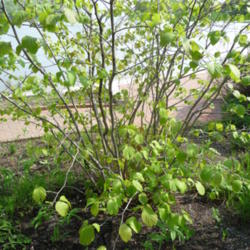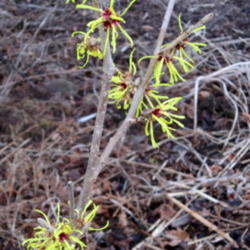Hamamelis virginiana is a most remarkable plant native to north America. It is also known as common or American witch hazel.
It is always in use as a true medicinal plant and it is a plant of great ornamental beauty. Hamamelis vernalis, or the Ozark Witch Hazel, is native to Central America. Hamamelis ovalis, or Leonard's Witch Hazel, was only found in 2004 and although an American native is new to science.
But there was something else about these, and especially the American Witch Hazel, or Hamamelis virginiana, which grew in the park, that fascinated me: its medicinal use.
The North American Indians use this plant, as do many other people and companies, as a liniment, an after-shave for men, and an additive in soaps, ointments, cosmetics, etc. It is commercially grown on a large scale for this purpose.

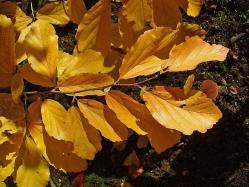 Hamamelis virginiana in the spring, summer, and autumn/fall. The seed heads are dehiscent and can fire the two black seeds up to 10 meters.
Hamamelis virginiana in the spring, summer, and autumn/fall. The seed heads are dehiscent and can fire the two black seeds up to 10 meters.
Many people swear by this plant's astringent healing properties. For instance, this plant contains hamamelitannins containing a cytotoxic activity, which can have an effect against colon cancer.
It is brilliant if made into a liniment and balms by use of the boiled bark and leaves. For sores and especially bruises, it is excellent. There are many recipes that are used to make these, and they are available to view on the Internet. Some contain rubbing alcohol.
Witch hazel can be applied to burns, bruises, insect bites, poison ivy rashes, and aching muscles. It can also be used to clean oily skin and to remove make-up. Of course, this is for external application! It consists mainly of ascorbic acid, acetaldehyde, astragalin, beta-ionone, choline, gallic acid, hamamelidin, isoquercitrin, kaempferol, myricetin, phenol, quercitin, quercitrin, safrole, and spiraeoside.

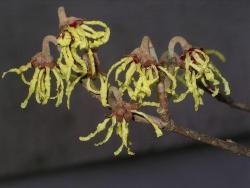 The flowers of Hamamelis virginiana are scented, and the leaves can be as well. Of course, the American witch hazel, Hamamelis virginiana, grows all the way up to Canada, so it is rather hardy. We do have Hamamelis virginiana in the UK, and it thrives here.
The flowers of Hamamelis virginiana are scented, and the leaves can be as well. Of course, the American witch hazel, Hamamelis virginiana, grows all the way up to Canada, so it is rather hardy. We do have Hamamelis virginiana in the UK, and it thrives here.
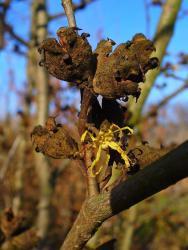 There are other witch hazels in America, of course. Hamamelis vernalis, pictured on the left, is one that grows on the Ozark Plateau and is native to central North America. On the right is Hamamelis virginiana, with flowers and seed pods. Another American native witch hazel is Hamamelis ovalis, or Leonard's witch hazel. This very rare Hamamelis was only discovered in 2004 in Southern Mississippi, but it straddles two counties in different states: southern Mississippi and Alabama. It grows in shallow flat-bottomed ravines and on adjacent low slopes. It is also called the Big Leaved Witch Hazel because the leaves are the largest in any Hamamelis. The new leaves are white underneath. S.W. Leonard discovered this new-to-science plant. It is unusual because it has many flower colour variations, everything from red to rose pink, orange, deep wine red, and bi-coloured yellow. It is a small Hamamelis growing to about 8 feet tall. It may be difficult to get one, however, because it is classified as an endangered species.
There are other witch hazels in America, of course. Hamamelis vernalis, pictured on the left, is one that grows on the Ozark Plateau and is native to central North America. On the right is Hamamelis virginiana, with flowers and seed pods. Another American native witch hazel is Hamamelis ovalis, or Leonard's witch hazel. This very rare Hamamelis was only discovered in 2004 in Southern Mississippi, but it straddles two counties in different states: southern Mississippi and Alabama. It grows in shallow flat-bottomed ravines and on adjacent low slopes. It is also called the Big Leaved Witch Hazel because the leaves are the largest in any Hamamelis. The new leaves are white underneath. S.W. Leonard discovered this new-to-science plant. It is unusual because it has many flower colour variations, everything from red to rose pink, orange, deep wine red, and bi-coloured yellow. It is a small Hamamelis growing to about 8 feet tall. It may be difficult to get one, however, because it is classified as an endangered species.
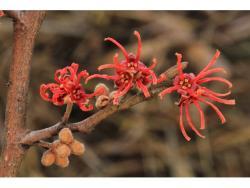
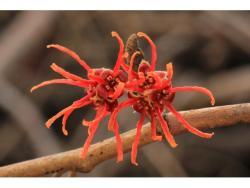
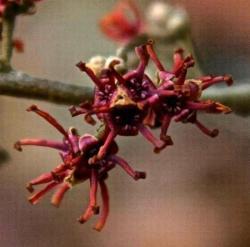
Hamamelis ovalis, or Leonard's Witch Hazel, in flower above. Photo courtesy of Alan Cressler and the Lady Bird Johnson Wildflower Center.
A lovely picture of Hamamelis ovalis with different-coloured flowers. Photo courtesy of Jane Unger, Hoot Owl Hollow Nursery, New Marshfield, Ohio.
In the UK the Hamamelis species usually flower in our late winter to early spring, as they do in America and indeed in other countries. There are a lot of wonderful cultivars and hybrids to be obtained, and some are heavily scented. They also have the benefit of flowering at a time of year when not much else is in flower. They produce great autumn/fall colour as well.. The Hamamelis japonica and Hamamelis mollis that I planted in the Victorian park are slow growing here in England, though some can achieve moderate growth rates. They are worth it, though, for they are stunning!
They are classified as a shrub, or sometimes as a small tree. Here they like a slightly acidic soil that is both organically rich and well drained. They hate wet soils and will not grow in shallow soils that overly chalk. They normally prefer full sun.
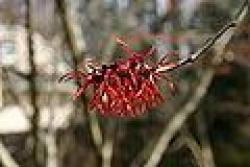

Hamamelis x intermedia 'Diane' and Hamamelis japonica in flower.
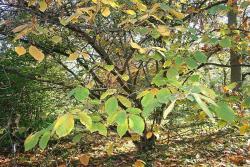
Hamamelis mollis, or the Chinese witch hazel, in leaf and flower.
I hope that this article, which provides only a tiny bit of information about a few of these remarkable and beautiful plants, may interest you enough to take notice of the gorgeous family of witch hazels.
My thanks to Gardengus, ge1836, Ridesredmule, Sheryl and allowed pictures from Wikipedia commons and public domain. Attr. H. Zell- Kurt Stüber- --SB_Johnny- Jean-Pol GRANDMONT
My thanks must also go to the kindness of the Ladybird Johnson Wildflower Center for the use of their amazing photos, which are in fact NPIN images, (Photo courtesy Alan Cressler and the Lady Bird Johnson Wildflower Center), of Hamamelis ovalis, which is considered an endangered species.
Also to the Hoot Owl Hollow Nursery New Marshfield, Ohio, who went out of their way to help me with their superb collection of Trees & Shrubs and Hamamelis pictures. The photo posted courtesy of Jane Unger allowed me to show some of the variation in flower colour.
